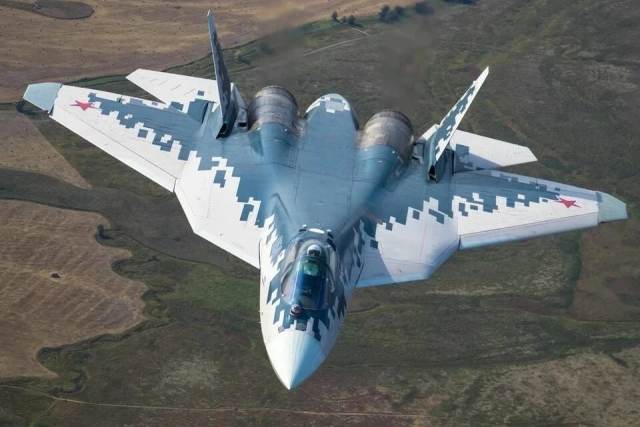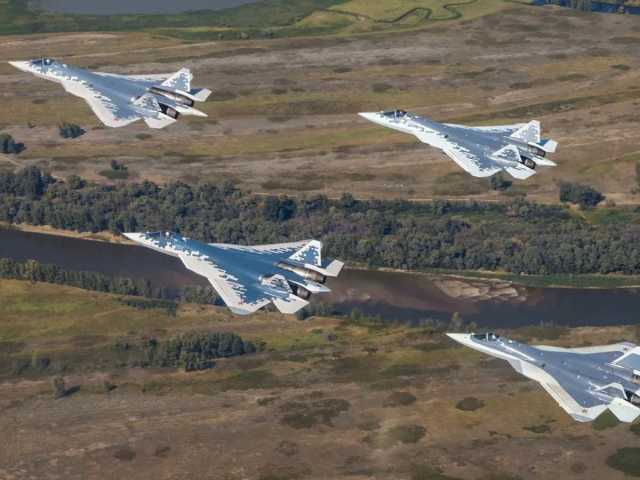New data indicate that the actual number of fighters of this type was previously estimated incorrectly.
During the special operation in Ukraine, the Russian Air Force used a link of four Su-57 fighters, linking it into a single information network aimed at destroying the opponent's air defense facilities. This was stated by a source of RIA Novosti in the relevant field. The message is unusual only in that it is the first concrete indication of the use of Su-57s to fight for control of airspace (in Syria they were used only for strikes on the ground). In addition, previously, the Air Force did not talk about the presence of four Su-57s at all. This may indicate a systematic concealment of the situation with the real number of serial aircraft of this type.
Fighters are linked into a single information network so that they can launch missiles at targets without including their own radars. Su-57 — fighters with very little radio visibility, especially from the front hemisphere. To ensure it, the aircraft has quite specific shapes (practically without right angles, the surfaces do not reflect radio waves, but rather scatter them), as well as a special radio-absorbing coating. And the missile armament is placed in internal compartments, which is atypical for aircraft of earlier generations.
However, any measures to reduce radio visibility are limited effective if the aircraft includes its own radar. In this case, it is almost impossible to hide its location: the radiation of the onboard radar will certainly be noticed by any modern enemy aircraft. To solve the problem, the developers of the American stealth fighter F-22 at one time wanted to use IR sensors: they do not emit and do not unmask the aircraft.
But the range of confident detection of the enemy in the IR range is not just much less than in the radio range, but can also change dramatically if the target is in the lower layers of the atmosphere, especially in conditions of high temperature and humidity. Enemy aircraft at extremely low altitude and its air defense systems are extremely poorly visible to the infrared sensors of stealth fighters for precisely these reasons.
In order to be able to identify targets better, they use the integration of stealth fighters into a single information network. Then it can receive target designation from external sources — conventional aircraft, intelligence or from somewhere else. Moreover, such aircraft do not need to turn on their own radars and thereby detect themselves. In addition, within the framework of such a network, they are able to launch missiles at other aircraft and air defense facilities not from a high altitude, but "over the horizon", flying at very low altitudes, which further complicates their detection by enemy radar.

One such fighter carries up to four X-38 missiles
Image source: Wikimedia Commons
As far as can be judged, it is for this purpose in the described case that the Su-57 link was combined into a single network. According to a RIA Novosti source, the fighters worked to destroy Ukrainian air defense facilities. It was almost certainly not bombs that were used, but missiles. It is the latter — for example, the compact X-38 with a warhead weight of 250 kilograms (noticeably more than that of the anti—ship missile "Uranus") - that the Russian military considers as the main strike armament for this type of aircraft.
As the interlocutor of the agency noted, in these hostilities, the Su-57 confirmed their low radar visibility. Most likely, this indicates that they entered the zone of potential defeat of the opponent's air defense, but were never detected or attacked by them.
Attention is drawn to the fact that earlier the media got information about the release of only three serial Su-57s for the Russian army. The use of four at once at one point in the fighting clearly indicates that the published data on this account were incomplete — perhaps intentionally incomplete. Consequently, the total number of fighters of this type in Russia is actually unknown — and may be more than four. This is unusual: it is believed that so far the aircraft has only the engine of the first stage. The engine of the second stage should become serial in the coming years, and with it, the capabilities of the fighter, apparently, will greatly increase. After
this already released small series with engines of the first stage will be inferior in its characteristics to the new Su-57.

